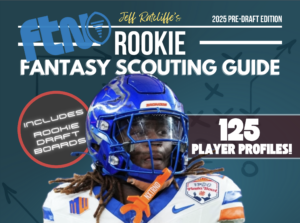
With only weeks to go before the start of the NFL season, I got a message from Kevin Adams:
“I have an idea for a new article. I want you to write it. It’s genius.”
And so, The Chalk Report was born. Essentially, this article will answer two questions as the season progresses — who is hitting and who is failing at each position? Last season, my Predicting NFL DFS Performance piece challenged a handful of industry assumptions:
- RBs are the most predictable because of their volume
- Pay up for stud RBs because their ceilings are incomparable
- Since WRs are more volatile, get contrarian there
- TEs are the most volatile and therefore the hardest to predict
No. 1 is wrong — WRs are more predictable and we’re better at identifying the best WR plays
No. 2 is wrong — once over $7k, price isn’t even predictive of performance. Plus, we often see popular stud RBs, but this is a position where we should be trying to diversify (except for value RBs)
No. 3 is wrong — it’s OK to diversify up top, but mid-tier WR chalk is the best chalk there is!
No. 4 is wrong — TEs are actually predictable, efficiently priced, and we as an industry are good at identifying the best plays.
Will this analysis hold throughout the 2022 regular season? There’s only one way to find out!
Defining the Chalk
We have two measures of rostership — the actual rostership and the rostership projections. Ideally, we could simply view actual rostership and define chalk from there, but the point of this analysis is to inform our behavior in future weeks, when the rostership projections will be the best measure of chalk that we have. Consequently, for a player to be defined as chalk, he must project as such AND be rosted as such, with some wiggle room for a player who ends up significantly more popular than expected (“gets steamed”).
The Chalk Report
I’ve added a category — instead of just hits and misses, I’ll also track smash rate. I’m defining “smash” as a performance that increases the chance of a takedown. For example, Carson Wentz was great this week and was certainly a hit, but Lamar Jackson and Tua Tagovailoa were needed for takedowns. Thus, Wentz was a hit but not a smash. We can summarize all definitions like so:
- Hit — increases the chance of the lineup cashing
- Smash — increases the chance of the lineup getting a takedown
- Dud — decreases the chance of the lineup cashing
Quarterback
Mega Chalk: Derek Carr
Chalk: Derek Carr, Carson Wentz
The verdict for Carr is a difficult one. Considering three QBs with at least moderate rostership destroyed him (Tua, Lamar and Wentz), he certainly wasn’t a hit. However, having him didn’t ruin your lineup, so he wasn’t a dud either. That leaves us with:
Running Back
Before we get into the hits and misses, I’m immediately stunned by the size of these deltas. Christian McCaffrey’s is on me. I was projecting significant steam for him that never came. Putting him aside, these deltas are still wild. I’m going to table the discussion on why this may be for the time being, but perhaps we should be less confident in the RB rostership projections than any other position’s.
Mega Chalk: Saquon Barkley
Chalk: Saquon Barkley, Darrell Henderson, Javonte Williams, Joe Mixon, Antonio Gibson
Amazingly, these players and RBs as a whole were so equally underwhelming that they can’t even be called duds. The results:
Wide Receiver
Mega Chalk: Davante Adams, Greg Dortch
Chalk: Adams, Dortch, Tyreek Hill, Jerry Jeudy (excluded due to injury), Ashton Dulin, Amon-Ra St. Brown, Curtis Samuel
Note: Why is Cooper Kupp not chalk at the same rostership as Ashton Dulin? Because as price increases, so does the average rostership. This is the same reason that Dortch qualifies as mega chalk.
Adams is the only dud, St. Brown and Hill smashed, and nearly everyone else hit (Dulin is a wash). In summary:
Tight End
I’m going to include Mark Andrews as chalk because in addition to projecting as such, he came in at double-digit rostership in many SE contests. He was also in over a quarter of lineups on the Early Only slate.
These three bring the TE data to:
Defense/Special Teams
The Bengals were such mega chalk that they were the only chalk. They were neither a hit nor a miss. DST results:
The analysis doesn’t stop here. The next question is where are the top scorers coming from at each position? Can the cheapest options compete from a ceiling perspective? What about the super contrarian options? Let’s find out.
Top Scorers
Quarterback
As expected, the lower number of stud QBs this week brought more of the cheaper options into the mix. For the second straight week, we also had a super contrarian option come out of the woodwork onto the top of the leaderboard (Wentz in Week 1 and Joe Flacco in Week 2). Still, I think the only takeaway here is we want to use QBs with at least moderate rostership.
Running Back
Week 2 epitomized every finding in last year’s RB analysis. Chubb rewarded those who were willing to severely differentiate up top, while the stunted ceilings of RBs as a whole allowed super contrarian options like Tony Pollard, Damien Harris and James Robinson to reach the top of the leaderboard while scoring about as many fantasy points as Greg Dortch. Stop paying for expensive RB chalk.
Wide Receiver
First of all, here’s a fun fact. 14 (!) WRs outscored every RB on the slate except for Nick Chubb. Plus, as great as Chubb was, he was outscored by five WRs, three of whom outscored him by approximately 10 DK points. I will not build a single lineup without a WR in the flex this season unless this pattern changes drastically.
Garrett Wilson is the first WR of the season to post a ceiling game at extremely low rostership, but the rule from Week 1 certainly held up well that we want to play as many of the league’s best WRs as possible. Note that doing so means focusing on the great mid-tier WRs, which is easy to stomach since they’ve shown an immense ceiling.
Tight End
Once again, an expensive TE absolutely dominated the slate by beating all other TEs by double digits. Yes, these stud TEs (Darren Waller is probably a part of a stud trio instead of Travis Kelce and Mark Andrews being the only two) have great ceilings, but so far, the separation has also come from the fact that TEs aren’t spiking the way WRs at similar prices have been able to.
Defense/Special Teams
Don’t play chalk defenses. Just don’t. The position is total chaos.
Final Thoughts & Single-Entry Lineup Guidelines
The delta trend we saw in Week 1 reversed in Week 2, as this time we saw the players who were the most steamed, like Amon-Ra St. Brown, deliver. I fear that this analysis is useless without a better way to isolate which players got steamed from the ones that rostership projections were simply inaccurate for. Consequently, I’m going to start tracking the change in rostership projections from the first detailed run to the last update before kickoff.
In the meantime, I’ve removed the last single-entry lineup guideline from the Week 1 Chalk Report. Plus, it’s more important that we focus on the RB & WR takeaways, anyway. The public will eventually catch up, so we want to hammer this edge while we still can.
When building my Week 3 single-entry lineup, I’m left with four guidelines:
- Prioritize mid-tier WR chalk
- Every WR used should be a great WR (no unnecessary risks at the position)
- Prioritize expensive TE chalk
- The QB should be at least moderately rostered












































 New York Jets
New York Jets  New England Patriots
New England Patriots  Miami Dolphins
Miami Dolphins  Buffalo Bills
Buffalo Bills  Pittsburgh Steelers
Pittsburgh Steelers  Cleveland Browns
Cleveland Browns  Cincinnati Bengals
Cincinnati Bengals  Baltimore Ravens
Baltimore Ravens  Tennessee Titans
Tennessee Titans  Jacksonville Jaguars
Jacksonville Jaguars  Indianapolis Colts
Indianapolis Colts  Houston Texans
Houston Texans  Las Vegas Raiders
Las Vegas Raiders  Los Angeles Chargers
Los Angeles Chargers  Kansas City Chiefs
Kansas City Chiefs  Denver Broncos
Denver Broncos  Washington Commanders
Washington Commanders  Philadelphia Eagles
Philadelphia Eagles  New York Giants
New York Giants  Dallas Cowboys
Dallas Cowboys  Minnesota Vikings
Minnesota Vikings  Green Bay Packers
Green Bay Packers  Detroit Lions
Detroit Lions  Chicago Bears
Chicago Bears  Tampa Bay Buccaneers
Tampa Bay Buccaneers  New Orleans Saints
New Orleans Saints  Carolina Panthers
Carolina Panthers  Atlanta Falcons
Atlanta Falcons  San Francisco 49ers
San Francisco 49ers  Seattle Seahawks
Seattle Seahawks  Los Angeles Rams
Los Angeles Rams  Arizona Cardinals
Arizona Cardinals 








 Boston Celtics
Boston Celtics  Brooklyn Nets
Brooklyn Nets  Philadelphia 76ers
Philadelphia 76ers  New York Knicks
New York Knicks  Toronto Raptors
Toronto Raptors  Chicago Bulls
Chicago Bulls  Detroit Pistons
Detroit Pistons  Milwaukee Bucks
Milwaukee Bucks  Cleveland Cavaliers
Cleveland Cavaliers  Indiana Pacers
Indiana Pacers  Orlando Magic
Orlando Magic  Atlanta Hawks
Atlanta Hawks  Charlotte Hornets
Charlotte Hornets  Miami Heat
Miami Heat  Washington Wizards
Washington Wizards  Denver Nuggets
Denver Nuggets  Minnesota Timberwolves
Minnesota Timberwolves  Oklahoma City Thunder
Oklahoma City Thunder  Portland Trail Blazers
Portland Trail Blazers  Utah Jazz
Utah Jazz  LA Clippers
LA Clippers  Golden State Warriors
Golden State Warriors  Los Angeles Lakers
Los Angeles Lakers  Phoenix Suns
Phoenix Suns  Sacramento Kings
Sacramento Kings  Dallas Mavericks
Dallas Mavericks  Houston Rockets
Houston Rockets  Memphis Grizzlies
Memphis Grizzlies  New Orleans Pelicans
New Orleans Pelicans  San Antonio Spurs
San Antonio Spurs 










